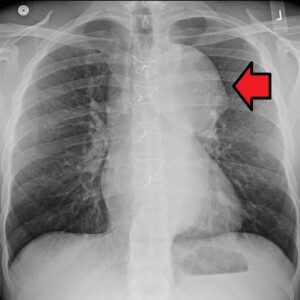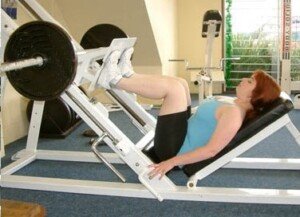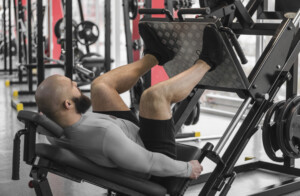Can straining hard on a leg press machine that’s piled with plates cause your thoracic aortic aneurysm to rupture due to the blood pressure spike?
The nice thing about the popular floor leg press equipment is that it provides stability to the spine and thus, isolates the lower body during a set.
Though we’ve all seen the guy who has the gym’s entire supply of 45-pounders loaded on the machine and lowers the sled only eight inches before pushing back up, there are other users who actually execute full range of motion with a ton of weights on the machine.
They grind out each rep, the strain clearly visible on their grimacing faces.
But even if you don’t work out with as much weight as they do, you can still build up a significant amount of intrathoracic pressure, along with a big blood pressure spike, when using this equipment.
This is dangerous if you have a bulging section in your aorta.
Most diagnoses are the result of an incidental finding on an imaging exam for an unrelated reason.
For example, the aorta gets imaged during a coronary calcium scoring with a CT machine.
Or, a chest X-ray for suspected pneumonia or broken ribs will pick up a thoracic aortic aneurysm.

Thoracic aortic aneurysm. James Heilman, MD/CC BY-SA 4.0 creativecommons.org/Wikimedia Commons
It may not be big enough to qualify for surgical repair, and this pathology usually doesn’t cause symptoms.
Typically, the bulge must be at least 5.5 cm to qualify for surgery. Or, if it’s smaller but causing symptoms, it will qualify.
Otherwise, the patient is told to modify their lifestyle to prevent blood pressure spikes. This means avoid heavy weightlifting.
What about specifically, though, the leg press machine?
This is a device that gives its user the potential to eventually push against a very heavy amount of resistance.
The potential is there for an ample amount of straining, leading to high loads of intrathoracic pressure.
The Leg Press and Thoracic Aortic Aneurysm: Guidelines

George Stepanek, CreativeCommons
Here are the guidelines for doing leg presses if you have a thoracic aortic aneurysm, according to Alexandra Kharazi, MD, a cardiothoracic surgeon with CVTS Medical Group, Inc., Chula Vista, CA.
“Starting light, using the equipment properly and paying attention to symptoms as you are using the leg press (dizzy, chest pain, shortness of breath).
“Small range of motion with a ton of weight would potentially cause a more rapid blood pressure spike (similar to straining) than the full range of motion method.”
To worry less about a sudden tearing in your aneurysm, avoid putting a lot of weight on the machine, even if you intend on doing only a small range of motion.
If the weight is heavy enough, that small range of motion – which may appear as cheating to observers – can still require plenty of straining (and hence, a quick rise in blood pressure) to repeatedly push up and lower.
With a full range of motion, however, in which your knees are brought down to your chest, you’ll have no choice but to use a lighter weight load.
If you conduct 12-15 reps with a full ROM, you may feel a lot of “burning” in your quads, but you won’t have to strain as much due to the light load that would allow 12-15 reps.
Sets of below 12 reps are not advised, because this lower number will encourage the user to work out heavy – heavy enough to put the body through strain and generous fast spikes in blood pressure.
You’ll want to strive for metabolic fatigue, not mechanical fatigue.
Metabolic fatigue means the set is becoming increasingly more difficult due to your quads feeling “on fire.”
Mechanical fatigue means that the set is getting harder because the weight is just too heavy.
Additional Leg Press Guidelines with a Thoracic Aortic Aneurysm
Never hold your breath at any point during a set. Never.
If you’re tempted to hold your breath while straining to push the sled away from you, this means the weight is too heavy for your medical condition.
Even if the resistance is light enough for you to complete 20 reps, you should NEVER hold your breath.
The proper breathing technique is to breathe IN as you lower the sled towards your chest (or release it towards your chest if you’re using a horizontal device), and then, breathe OUT as you push the sled away from your chest.
As you’re exhaling, do not pause with this. Maintain the exhalation all the way till your legs are straight (never lock out the knees, though).
Keep your feet flat on the sled. This is correct form, whether or not you have a thoracic aortic aneurysm.
To minimize the risk of an aortic dissection while doing leg presses, you should use a weight load for which you can actually do several more reps out of a 12-15 set, rather than using a load for which 12-15 is a rep max.
 Dr. Kharazi has many areas of surgical expertise including the following: aortic aneurysm repair, aortic valve repair and replacement, and CABG. Other areas of focus include arrhythmia, bloodless medicine, lung cancer and resection, septal defect repair and thoracic surgery.
Dr. Kharazi has many areas of surgical expertise including the following: aortic aneurysm repair, aortic valve repair and replacement, and CABG. Other areas of focus include arrhythmia, bloodless medicine, lung cancer and resection, septal defect repair and thoracic surgery.
 Lorra Garrick has been covering medical, fitness and cybersecurity topics for many years, having written thousands of articles for print magazines and websites, including as a ghostwriter. She’s also a former ACE-certified personal trainer.
Lorra Garrick has been covering medical, fitness and cybersecurity topics for many years, having written thousands of articles for print magazines and websites, including as a ghostwriter. She’s also a former ACE-certified personal trainer.
.










































